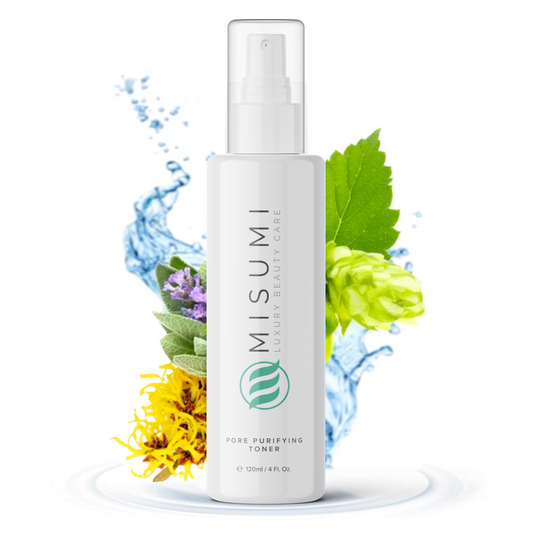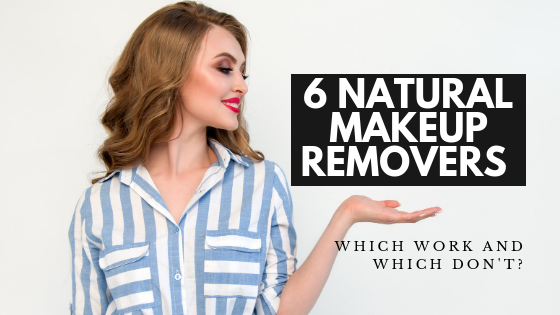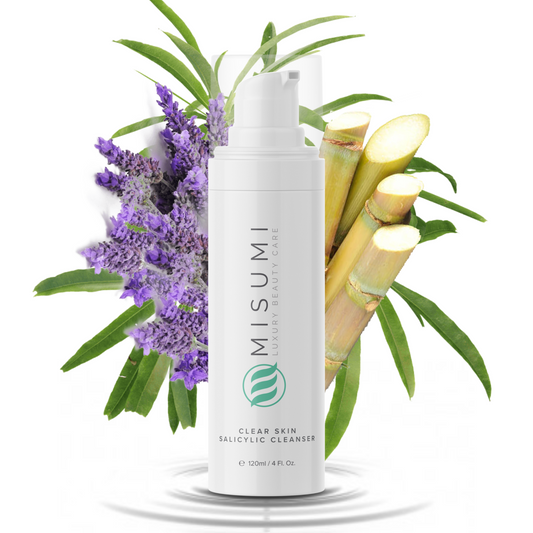Makeup is part of our daily life, no matter whether you’re only using foundation and mascara or you have 17 essential products. We’re all different, yet most of us enjoy the effects of a good makeup routine.
Over time, people have found many arguments against using makeup, like the controversial topic of whether makeup causes acne. Here at Misumi, we believe that makeup isn’t necessarily good or bad. However, the way you use it is much more important.
It's essential to remove your makeup properly. That's why we’re here to discuss the end-of-the-day routine when your makeup comes off.
Because makeup is such a big part of our lives, you’ll find an abundance of makeup-removing products on the market, including wipes, micellar water, oil cleansing products, oil-based removers, water-based removers, and so much more.
Whether you’ve tried a bunch that didn’t work or you want to try natural alternatives, we’ll break down the most commonly used natural makeup removers and leave you with a better understanding of what’s good for your skin. We'll help you find the perfect skin routine.
Not everything will work on your skin. You need to know your skin type and the ingredients that are best for it.
So, let’s dive in.
Why Natural Ingredients?

Makeup is part of our daily life, no matter whether you’re only using foundation and mascara or you have 17 essential products. We’re all different, yet most of us enjoy the effects of a good makeup routine.
Over time, people have found many arguments against using makeup, like the controversial topic of whether makeup causes acne. Here at Misumi, we believe that makeup isn’t necessarily good or bad. However, the way you use it is much more important.
It's essential to remove your makeup properly. That's why we’re here to discuss the end-of-the-day routine when your makeup comes off.
Because makeup is such a big part of our lives, you’ll find an abundance of makeup-removing products on the market, including wipes, micellar water, oil cleansing products, oil-based removers, water-based removers, and so much more.
Whether you’ve tried a bunch that didn’t work or you want to try natural alternatives, we’ll break down the most commonly used natural makeup removers and leave you with a better understanding of what’s good for your skin. We'll help you find the perfect skin routine.
Not everything will work on your skin. You need to know your skin type and the ingredients that are best for it.
So, let’s dive in.
Our Best-Selling Acne Kit

At Misumi, we make clear skin easy and manageable with this 2-step cleanse and tone routine. Unclog pores and restore clear, healthy skin with natural ingredients. Try our signature products today.290 reviews$49.95SEE BEFORE & AFTER
Why Natural Ingredients?

Before we list all the benefits of using natural or DIY ingredients as organic makeup removers, let’s get something clear. It’s not our intention to start a war on bought versus DIY or natural versus synthetic. Discrimination between products is not only pointless but also misleading.
Whether something is good for you depends on many factors, such as your skin type, current skin condition, other products you’re using, the quality and purpose of the products, and how you’re using them.
With this in mind, what are the benefits of using natural ingredients to remove makeup?
There are always times when you find yourself without a makeup remover, so you have to improvise. Not to mention, it’s cheaper. You might not want to spend money on expensive makeup products.
Natural removers are equally effective but gentle at the same time. Some leave the skin moisturized and soft. Many also have a highly nutritious profile loaded with vitamins and minerals which can nourish and heal the skin simultaneously.
If you try out DIY removers, here’s everything you need to know about them.
How Does DIY Natural Makeup Removers Work?

Natural makeup removers work much the same as store-bought ones, by dissolution or solubilization. This means the ingredients you’re applying should be able to break the bonds between the makeup and the cells on the skin’s surface. Separated from the skin, makeup residue can be wiped off with a cotton pad or rinsed with water.
For example, when you apply foundation, it dries and mimics the skin beneath it. Dry towels, cotton pads, or other tools can irritate the skin if you're too harsh.
Removers contain ingredients that can dissolve or encapsulate makeup and gently remove it from the face.
Safe Ingredients For Your DIY Makeup Removal

Many natural ingredients can remove makeup, but the secret to soft, smooth, and clean skin is knowing which ingredients are the right choice for your skin type. And, of course, are there any risks or side effects?
Coconut Oil as a Makeup Remover
Coconut oil is a highly saturated ingredient extracted from raw coconut or dried coconut kernels. It's mainly composed of medium-chain fatty acids, with lauric acid making almost 50% of the oil.
Pros:
Coconut oil is a thick, highly moisturizing ingredient that can remove makeup easily. It’s gentle on the skin and believed to have antibacterial, anti-inflammatory, anti-microbial, and antioxidative properties.
Aside from removing makeup, it benefits the skin by stimulating collagen production, killing harmful bacteria, and promoting wound healing. It can also remove waterproof makeup.
Cons:
The main problem with coconut oil is its high comedogenic rating. With a comedogenic rating of 4, it’s likely to clog pores. This is why it’s not recommended for oily and acne-prone skin.
On the other hand, some people with extremely dry skin can use it without experiencing adverse effects. You must be careful and think twice before applying it directly to the face.
Verdict:
The fact that coconut oil is frequently present in many skincare recipes, despite the problem with its comedogenicity, says a lot. Nevertheless, we advise diluting the oil and combining it with other non-comedogenic oils. And, if you have oily, acne-prone, or even a combination skin type, it’s best to choose some of the alternatives mentioned below.

Olive Oil as a Makeup Remover
Olive oil is known due to its high oleic acid content - an unsaturated fatty acid known for its many skin benefits. Although highly beneficial, oleic acid absorbs quickly into the skin, giving the oils a higher comedogenic value. However, don't rule it out. It has powerful moisturizing properties and ingredients, making it one of the best natural makeup removers around.
Pros:
Olive oil acts as a powerful antioxidant, scavenging free radicals. It also has antibacterial and anti-aging abilities. It’s loaded with A, E, D, and K vitamins, which can protect the skin, make it smoother, and prevent symptoms of premature aging.
Sick of stubborn eye makeup? Don't be - like coconut oil, olive removes waterproof mascara, eyeliner, and eyeshadow.
Cons:
Like coconut oil, olive oil has a questionable reputation as a trigger for breakouts. Some people find it too thick and heavy for their skin.
Verdict:
Olive oil can be a godsend for people with dry skin who want a natural makeup remover that won’t leave their face dry afterward. It can be too much for oily and acne-prone skin, as the oil leaves a greasy residue.

Mineral Oil (Vaseline or Petroleum Jelly) as a Makeup Remover
Another gentle but highly effective makeup remover is mineral oil. It has a large molecular size, which means it can penetrate the skin without clogging your pores. Its comedogenic rating is 0. Mineral oil has amazing occlusive and emollient properties (the degree to which the oil softens the skin).
Pros:
According to a study published in the Society of Cosmetic Scientists, the occlusive effects of mineral oil lead to increases in stratum corneum water content by reducing transepidermal water loss. It improves skin softness and is considered a safe ingredient for all skin types.
Cons:
Although mineral oil doesn’t clog the pores, it can still trap dirt, dead skin cells, and other impurities. This is because it forms a layer over the skin's natural moisture barrier. To avoid this, always cleanse your skin before using it. Additionally, because mineral oil doesn’t absorb into the skin, people with oily skin might dislike the greasy feeling.
Verdict:
Mineral oil deserves more recognition. It’s an amazing natural makeup remover that will leave your skin soft and smooth. With a comedogenic rating of 0, we can say it’s suitable for all skin types.

Sweet Almond Oil as a Makeup Remover
If you like almonds, you’ll love almond oil. It’s a wonderful ingredient with many benefits. Almond oil is packed with high amounts of vitamin E and healthy fats, which is where most benefits arise. It has a comedogenic rating of 2, meaning it’s unlikely to clog your pores. You can use it to remove water-resistant makeup safely.
Pros:
Aside from removing makeup, almond oil is a powerful antioxidant, protecting the skin from oxidative stress, sun damage, and symptoms of premature aging.
Cons:
Make sure you’re not allergic to nuts. People with nut allergies might experience a mildly negative reaction when applying the oil directly to the skin. It’s important to do a patch test before you use almond oil for the first time.
Verdict:
Sweet almond oil is another well-balanced ingredient - gentle, beneficial, and effective. It can help people with sensitive, dry, or acne-prone skin, although it’s a safe organic makeup remover for all skin types.

Jojoba Oil as a Makeup Remover
When we’re talking about balance, we can’t skip jojoba oil. Coming from a strong plant that survives very harsh climate conditions, the nut of the jojoba plant has many beneficial properties. Organic jojoba oil is one of the top choices for makeup removal.
Pros:
Jojoba oil is one of the most gentle oils, which is why it’s frequently used as a base and carrier oil in many recipes containing essential oils. It's non-comedogenic and suitable for all skin types. Organic jojoba oil is believed to moisturize the skin, kill certain bacteria, prevent oxidative stress, stimulate collagen production, and control sebum production - all without irritating the skin.
Cons:
It’s hard to find a downside to this oil - it seems to have it all. Because it’s hypoallergenic, it’s considered safe, but it’s always a good idea to do a patch test before trying it for the first time.
Verdict:
Unless you have extremely dry skin and want something thicker like coconut or olive oil, or you have an extremely oily complexion and want something more watery like witch hazel, jojoba oil is a smart and safe choice.

Witch Hazel as a Makeup Remover
Witch hazel is a potent healing ingredient that's been used in medicine for many years. Today, it’s used in cosmetics to tighten the skin and relieve acne symptoms. Unlike the above-mentioned alternatives, witch hazel is a thin and watery ingredient that can potentially treat many skin conditions. According to anecdotal evidence, witch hazel removes all water-based and oil-based makeup in a swipe. It'll also get rid of all that excess oil, too.
Pros:
Witch hazel is a blessing for people suffering from oily skin. It doesn’t leave a greasy residue, yet it can still very effectively remove makeup and soften the skin. It also tightens the pores and helps prevent frequent acne breakouts.
Cons:
Witch hazel is gentle, but if you don’t moisturize the skin after, it can dry it out. This is bad news for people with dry skin.
Verdict:
Witch hazel is an amazingly effective makeup remover, most suited for oily and acne-prone skin. Just make sure to hydrate your skin afterward, using a moisturizer designed for oily skin.

Our Simple Makeup Removal Blends for Each Skin Type
Normal Skin Type
Use sweet almond oil and aloe vera if you have a normal skin type. This blend can remove makeup easily and without pressure. Aloe vera will refresh and soothe the skin.
Ingredients:
- 1 cup of sweet almond oil
- ½ cup of pure aloe vera gel
Method:
Mix both ingredients in a small bottle or container, and stir well until the substances blend completely. After this, close the container and store the mixture. To use it, pour a few drops on a cotton ball or pad and gently rub it over the face.

Dry Skin Type
If you have a dry skin type, you can use a thicker, more dense oil as a carrier, like coconut or olive oil. We chose olive oil for this recipe as it has a lower comedogenic rating, but it's down to personal choice.
Shea butter is a non-comedogenic ingredient with high concentrations of fatty acids and vitamins, making it one of the best DIY makeup remover recipes for replacing natural oils and softening dehydrated skin.
Ingredients:
½ cup of olive oil
½ cup of jojoba oil
¼ cup of shea butter
Method:
Mix all the ingredients in a small container. Warm the mixture over a low heat for a few minutes to fuse the ingredients and help them form a smooth blend. After this, store the mixture and use it whenever you need it.

Combination Skin Type
Mixing watery, skin-tightening ingredients with a potent, moisturizing, non-comedogenic oil is perfect for your combination skin.
This simple mixture allows you to easily remove makeup without suffering from dry patches or a greasy residue.
Ingredients:
½ cup of witch hazel extract
½ cup of jojoba oil
Method:
Mix both ingredients in a small container. Close it and shake it to blend the ingredients. After this, store it among your other skincare products, and apply it to a cotton ball whenever you need it.
Oily Skin Type
We chose a mixture without oils that can gently and effectively remove makeup. Witch hazel is perfect for oily and acne-prone skin. Aloe vera can soothe redness and irritation while killing harmful bacteria.
Ingredients:
½ cup of witch hazel
½ cup of aloe vera
Method:
Mix the ingredients in a small bottle and stir or shake until the substances blend. After this, store it and use it whenever you need to remove your makeup.

Sensitive Skin Type
Mineral oil is a great ingredient for sensitive skin because it has a large molecular size and can’t penetrate the skin. This prevents it from irritating the face. Aloe vera is also a soothing and calming ingredient, making it great for sensitive skin.
Ingredients:
½ cup of mineral oil
½ cup of aloe vera gel
Method:
Mix both ingredients and still well until you get a smooth paste-like consistency. To use it, dip the cotton pad in the paste and gently rub it on a clean face. Don’t use pressure!
Aftercare: How To Properly Finish Your Routine

After you remove your makeup, it’s important to rinse with lukewarm water and apply a moisturizer or night cream. This simple step will prevent your skin from drying out or leaving a greasy residue.
If you have a specific skincare routine before bed, that’s even better. Remove your makeup gently and thoroughly. Then, rinse off with lukewarm water. You can start your routine when your skin is completely clear and clean. Don’t ever apply skincare products over makeup.
Conclusion
Whether you want to remove your eye makeup or an entire face of makeup, it doesn't hurt to try a natural or homemade makeup remover. The best natural removers should whisk away excess oil, clear the skin of stubborn makeup, and remove any other impurities.
If you want to make your own makeup remover, always make sure to choose the best ingredients for your skin type.
References
A review on the extensive skin benefits of mineral oil
In vitro anti-inflammatory and skin protective properties of Virgin coconut oil









